Zürich: A city and its trams
Chapter 2: Threats and survival
Zürich tram main page | articles list
<previous chapter | table of contents | next chapter>
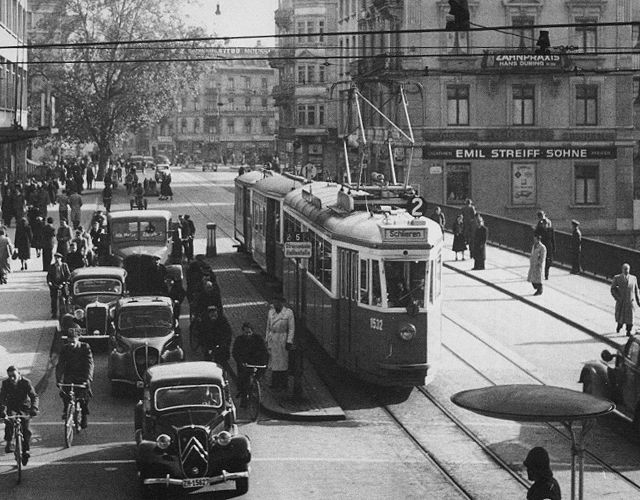 As new Standard Trams took to the rails in Zürich, clouds were already gathering on the horizon. Motor traffic, although still low, was on the rise and trams were getting caught up in congestion. The Standard Tram may have revolutionised tram travel in terms of comfort, speed and efficiency, but was no better than its predecessors at dodging traffic.
As new Standard Trams took to the rails in Zürich, clouds were already gathering on the horizon. Motor traffic, although still low, was on the rise and trams were getting caught up in congestion. The Standard Tram may have revolutionised tram travel in terms of comfort, speed and efficiency, but was no better than its predecessors at dodging traffic.
The solution of the era was the trolleybus. Zürich's first trolleybus route was inaugurated in 1939. In 1944 a plan was approved to replace secondary tram routes by trolleybuses. In the 1950ies, it was similarly proposed to upgrade main tram routes to pre-metro (Tiefbahn) by placing them in subways. Nobody was prepared to break a lance for the classic tram. Its days suddenly seemed numbered.
Of the trolleybus conversion plan, only a small part was actually implemented. The first tram line to be withdrawn was route 1 (Burgwies-Hardplatz) which was converted to trolleybus route 31 between 1954 and 1956. This was followed by the Farbhof-Schlieren section of route 2 (1956-8) which became a westward extension of the same trolleybus route. First regrets were voiced not long after the changes had taken effect. The trolleybus service struggled to cope with peak loadings and, contrary to expectations, punctuality did not improve. Proposals to reverse the error have resurfaced many times since, and as shall be seen later, are now closer to being realised than ever before!
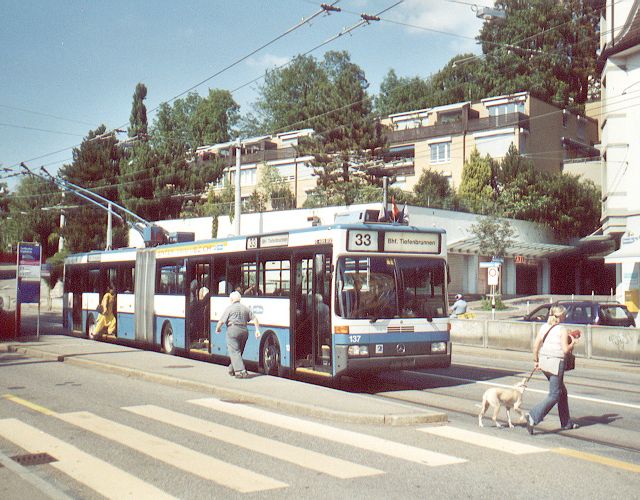 In the late 1950ies, planners quietly dropped further trolleybus conversion ambitions. All trolleybus routes opened before or since route 31 serve needs not previously covered by trams. Many of these do not venture into the centre but provide semi-ring like connections between neighbourhoods. Not only do they allow swift and direct journeys against the grain of the main commuter flows, but in doing so relieve pressure on the central network. On account of the hilly nature of these routes and the (relatively) light loadings, trolleybuses have proved themselves to be a particularly well-suited, clean and quiet solution (as is made quite clear whenever motor buses are called upon to help out). The latest trolleybus extension opened in 1998.
In the late 1950ies, planners quietly dropped further trolleybus conversion ambitions. All trolleybus routes opened before or since route 31 serve needs not previously covered by trams. Many of these do not venture into the centre but provide semi-ring like connections between neighbourhoods. Not only do they allow swift and direct journeys against the grain of the main commuter flows, but in doing so relieve pressure on the central network. On account of the hilly nature of these routes and the (relatively) light loadings, trolleybuses have proved themselves to be a particularly well-suited, clean and quiet solution (as is made quite clear whenever motor buses are called upon to help out). The latest trolleybus extension opened in 1998.
Rolling stock for the transition
If Zürich was to go ahead with its Tiefbahn vision, a new car design would be required. Most of the existing fleet, including the Standard Trams, were not considered suitable for subway operation. A new design was needed to take the city forwards. During the late 1950's and early 1960's, Basel and Bern invested in a second generation of Standard Tram. While conserving much of the original concept and appearance, the electrical equipment and many details were updated. The design was, however, no more suitable for the Tiefbahn than its predecessor. From 1959-60, Zürich took delivery of the P16 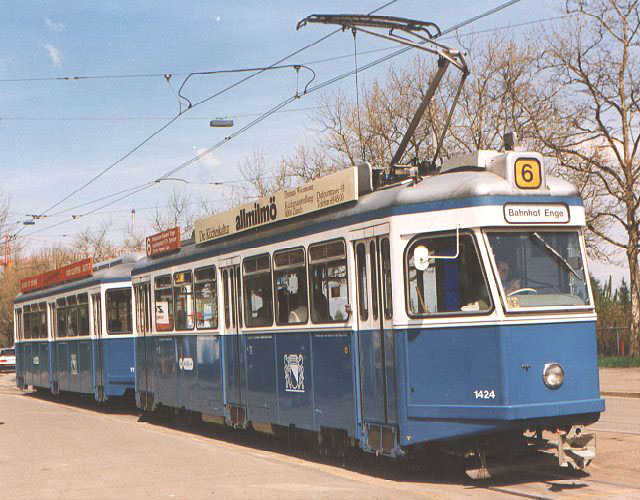 or Karpfen (carp) type (1416-1430 and trailers 771-786). Although technically closely related to the modernised Standard Tram, the body shape was fundamentally different: The doors were fitted flush with the platform face to facilitate boarding at underground stops. The non-door sides were prepared to have similar doors fitted later if required [9]. These constraints drastically compromised the tapering of the car ends. The result was an exceedingly wide swept path in curves, leading to the P16's being banned from many locations during their early years. This limited the routes the cars could be used on and no further batches were ordered. Struggling to solve this conundrum, VBZ [10] took a step back and acquired 12 Tiefbahn incompatible trailers of the Standard Tram family (787-798) in 1962.
or Karpfen (carp) type (1416-1430 and trailers 771-786). Although technically closely related to the modernised Standard Tram, the body shape was fundamentally different: The doors were fitted flush with the platform face to facilitate boarding at underground stops. The non-door sides were prepared to have similar doors fitted later if required [9]. These constraints drastically compromised the tapering of the car ends. The result was an exceedingly wide swept path in curves, leading to the P16's being banned from many locations during their early years. This limited the routes the cars could be used on and no further batches were ordered. Struggling to solve this conundrum, VBZ [10] took a step back and acquired 12 Tiefbahn incompatible trailers of the Standard Tram family (787-798) in 1962.
Before the P16's had entered service, it was recognised the Tiefbahn would require even larger cars. In 1960, a prototype was delivered of an articulated car based closely on the P16 design (1601 [11]). It was intended to later produce a matching articulated trailer to provide a high capacity formation for the heaviest tram routes. Although technically satisfactory, this car had the same excessive swept path that hampered the usefulness of the P16's.
1601 was soon followed by another high capacity Tiefbahn design with a significantly reduced swept path. This was achieved by using a four-wheeled centre section instead of a bogie (similar to many present low-floor designs). Two cars of this type were delivered to Basel [12] and a third to Zürich (1701 [13]).
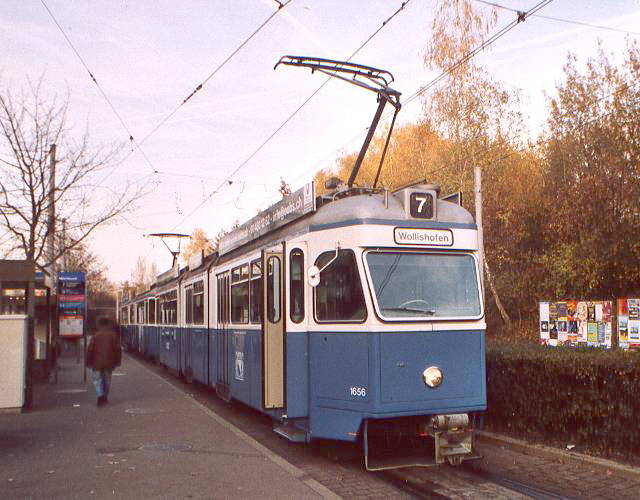 Experience with 1701 prompted the decision not to motorise the centre truck [14]. This modification, however, left insufficient adhesion to haul an articulated trailer on gradients - the latter would have to be replaced by a second powered unit. These changes drove up unit production costs and caused the schedule to slip further. When series production (1601-1726) finally began in 1966, the cars had earned themselves the name of Mirage in mischievous analogy to the fighter jets whose acquisition in Switzerland had been heralded by similar delays and cost escalations.
Experience with 1701 prompted the decision not to motorise the centre truck [14]. This modification, however, left insufficient adhesion to haul an articulated trailer on gradients - the latter would have to be replaced by a second powered unit. These changes drove up unit production costs and caused the schedule to slip further. When series production (1601-1726) finally began in 1966, the cars had earned themselves the name of Mirage in mischievous analogy to the fighter jets whose acquisition in Switzerland had been heralded by similar delays and cost escalations.
Zürich had long hoped that Mirage was to be a new generation of standard tram. This was not to be as Basel had since lost patience and opted for off the shelf Duewag cars instead. Once initial teething troubles had been overcome, the Mirage trams operated successfully. Although delivered in 1966-69, all 126 vehicles are still in service. They are operated in coupled pairs or solo according to need, but also haul Standard trailers on lines without steep gradients. It was the Mirage that finally permitted the bulk of the remaining four-wheelers to be retired [15].
In the meantime, Tiefbahn route planning was forging ahead. Besides proposals to move trams from some of the major thoroughfares into subways, a complete redesign the centre area network was envisaged. An underground ring was projected into which radial lines would feed. It was, however, observed that the peripheral locations of stops might have undesirable influences on trading patterns and city development. Some cross-city subways were added to address this issue.
In 1962 a referendum was held over the Tiefbahn. The project was rejected by 53'893 votes to 34'307, a defeat that took the promoters by surprise. Much has been speculated about the lessons that should have been learnt from this. Definitely, local identification with, and pride in the tram were factors that had been underestimated. Many opponents also asked why so much money had to be spent to create what was essentially already there.
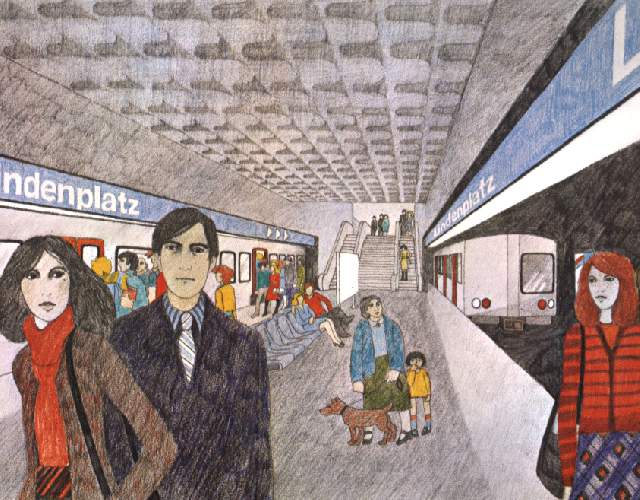 The tunnel faction soon started work on a new proposal: a full scale underground. This U-Bahn was to be operationally independent of the tram system. It would be standard gauge using a third rail power supply. A first line was to run from Dietikon via Farbhof, Hauptbahnhof, Schaffhauserplatz, Milchbuck and Oerlikon to the airport, with a short branch from Milchbuck to Schwamendingen. This was far more than a tram replacement, as it ran further into the suburbs than any tram of the period (or indeed today) did. The U-Bahn was to use a combination of deep level and cut and cover tunnels with surface running or the occasional flyover in the outskirts.
The tunnel faction soon started work on a new proposal: a full scale underground. This U-Bahn was to be operationally independent of the tram system. It would be standard gauge using a third rail power supply. A first line was to run from Dietikon via Farbhof, Hauptbahnhof, Schaffhauserplatz, Milchbuck and Oerlikon to the airport, with a short branch from Milchbuck to Schwamendingen. This was far more than a tram replacement, as it ran further into the suburbs than any tram of the period (or indeed today) did. The U-Bahn was to use a combination of deep level and cut and cover tunnels with surface running or the occasional flyover in the outskirts.
Plans also considered the effect on the tram system. Lines running directly parallel to the U-Bahn were to be dismantled. Shorter tangential chords were proposed to reconnect sections that would otherwise have become isolated. The project also recommended some extensions to tram lines whose long-term survival was likely.
Although station to station journey times by U-Bahn would doubtlessly have been shorter than anything the tram could offer, such figures would not necessarily have translated into real benefits. For example, today there are two direct tram corridors from Hauptbahnhof/Central to Schaffhauserplatz serving 7 intermediate stops between them. The U-Bahn would not only have eliminated both lines, but would have offered only one intermediate station on this section. This would have resulted in longer walks to the station for most users as well as more time spent getting to the platform (the station would have been in a deep level tunnel and reached by long escalators).
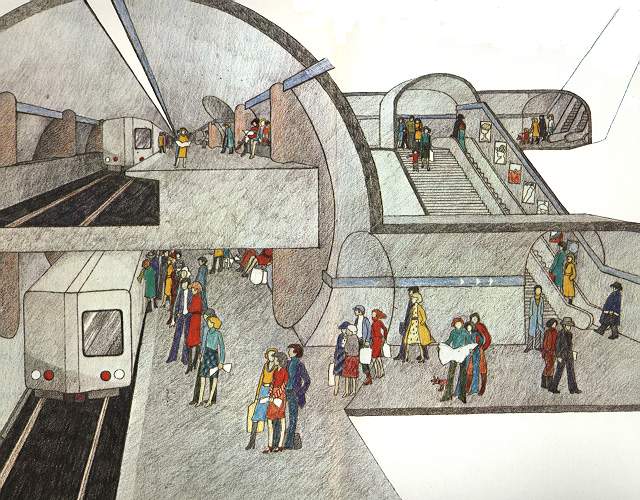 Another important effect, which such proposals fail to take into account, is that people often choose their place of residence because of the proximity of an attractive transport link to their workplace. If that link is replaced by a new one going somewhere else, it is not to the advantage of the user, however modern and fast it may be.
Another important effect, which such proposals fail to take into account, is that people often choose their place of residence because of the proximity of an attractive transport link to their workplace. If that link is replaced by a new one going somewhere else, it is not to the advantage of the user, however modern and fast it may be.
The great strength of the U-Bahn proposal lay in it serving outlying areas not served by trams. Today these are served by the S-Bahn suburban rail network and indeed plans are in the pipeline to (re)extend trams there too. In 1980, a main line rail connection to the airport opened, providing faster and more comfortable journeys into the centre than a U-Bahn ever could.
In 1973, the U-Bahn was rejected in a referendum by 123'210 votes to 50'114 [16]. There has been much licking of wounds over this second defeat. Indeed there are public transport experts, both in Zürich and elsewhere who still consider this rejection the most strategic and fundamental of errors in Zürich's transport history. According to their arguments, Zürich is hardly worthy of the model character that is often bestowed on it, because preferring long-term inactivity to transition can hardly be model behaviour. In the author's opinion such arguments fail to acknowledge the success that Zürich undoubtedly has. Sometimes it takes more courage to admit that the status quo is good than to tear everything down and start from scratch.
 Some construction was allowed to begin ahead of the referendum. This was the case where prolonged indecisiveness would have delayed other projects. The shopping centre, Shop Ville, built below Bahnhofplatz included a U-Bahn station. A motorway section between Milchbuck and Schwamendingen (itself partly in tunnel) had a U-Bahn tunnel built below it. Both investments have since been put to good use. The Shop Ville structure is now used by S-Bahn trains [17]. As shall be seen later, the Schwamendingen section has become a tram subway. The author is unable to ascertain the fate of the U-Bahn station built below the airport terminal.
Some construction was allowed to begin ahead of the referendum. This was the case where prolonged indecisiveness would have delayed other projects. The shopping centre, Shop Ville, built below Bahnhofplatz included a U-Bahn station. A motorway section between Milchbuck and Schwamendingen (itself partly in tunnel) had a U-Bahn tunnel built below it. Both investments have since been put to good use. The Shop Ville structure is now used by S-Bahn trains [17]. As shall be seen later, the Schwamendingen section has become a tram subway. The author is unable to ascertain the fate of the U-Bahn station built below the airport terminal.
<previous chapter | table of contents | next chapter>
Zürich tram main page | articles list
Footnotes:
[9] Hence the irregular window arrangement on this side.
[10] VBZ (Verkehrsbetriebe Zürich). StStZ was renamed VBZ in 1950.
[11] Later 1702, now 1802.
[12] The Basel cars were 601 and 602.
[13] Later 1801.
[14] Thus reducing the unsprung mass of this section.
[15] Four-wheeler operation did not finally end until 1972.
[16] The considerably larger number of votes cast in comparison to the Tiefbahn referendum is because the former was a municipal referendum whereas the latter was cantonal.
[17] Platforms 1 and 2 at Hauptbahnhof.
<previous footnotes |
footnotes continued>
last updated: 14.12.05
counter added: 14.12.05